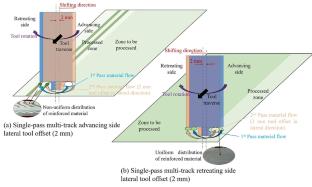Effect of Carbon Fibre Reinforcement on an Aluminium Metal Matrix Composite Joint Through Upward Friction Stir Processing
Abstract
The increasing demand for lightweight and high-performance materials aimed at reducing carbon footprints necessitates the development of innovative technologies. In this study, high-strength carbon fibre (CF) was utilized to reinforce the aluminium (Al) matrix for fabricating the metal matrix composite (MMC). It was found that strain, strain rate and temperature gradient play a significant role in non-uniform particle distribution at the advancing and retreating sides of the processed regions. To address these challenges, Upward Friction Stir Processing (UFSP) with a threaded pin tool was proposed to assess the uniformity of the reinforcing carbon fibres on the advancing and retreating sides, which is the novelty in this study. The influence of UFSP tool offset direction on material flow characteristics and particle distribution were analyzed. Carbon fibre agglomeration and band formation within the metal matrix was given special attention during UFSP technique. A double-pass UFSP was introduced which revealed a homogenous dispersion of CF upon microstructural characterisation. Furthermore, results demonstrated a 36% increase in bulk hardness and 54% increase of electrical conductivity compared to base metal. Thus, incorporation of a 2 wt% of CF yielded harder and better electrically conductive UFSP-ed metal matrix composite. This is expected to have a wider application in industrial joining methods while joining of two dissimilar metals or metal based composites.
Graphical Abstract



 求助内容:
求助内容: 应助结果提醒方式:
应助结果提醒方式:


